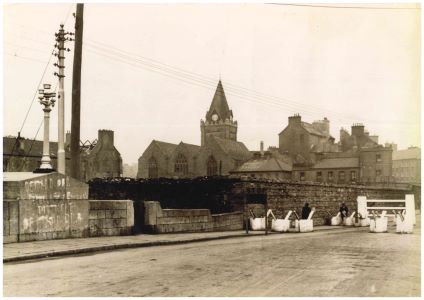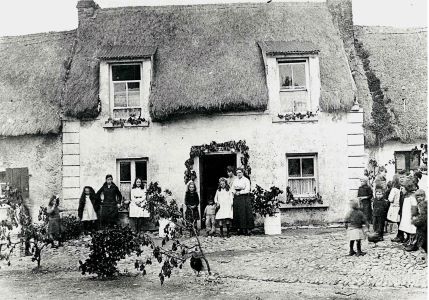Old Galway
O’BRIEN’S BRIDGE

by Tom Kenny
The Parliamentary Gazeteer of Ireland was published in 1845 and stated that “the old, or west bridge, over the main current of the Galway River, was built in 1342; and till the erection of the new bridge (The Salmon Weir bridge built 1819) was the only passage from the eastern districts of the county to the great peninsulated district of Iar-Connaught. In 1558, a gate and tower were erected at its west end; and afterwards, another gate and tower were erected in its centre; but these were long ago entirely demolished. About 42 years ago, the bridge was thoroughly repaired on its north side, and was pronounced by architects to be strong; but it soon experienced the effects of the neglect which are so generally apparent in the town; and in consequence of dilapidated parapets, narrow carriage-way and the utter want of side-pavements and of lights, it was, a few years ago, a rather hazardous means of crossing a deep and impetuous river on a dark night”.
THE WEST BRIDGE, A BRIEF HISTORY OF THE EARLY YEARS

by Tom Kenny
The City of Galway was known in ancient times as ‘Streamstown’ because the Galway River divided into several small waterways in addition to the main river. The river was much more spread out then and was fordable in some places. The city was placed on the east side of the river which acted as protection against the Irish families displaced by the Norman settlers who took over the area in the early 13th century. The walls of the city provided protection on the east and north side of the city and the various gates allowed access. The river was a barrier to trade with Iar-Chonnacht and so the merchant families began to feel the need to build a bridge to help expand trade, it would provide access to customers from the west, and also allow them to bring in their produce, fruit, vegetables, meat, hay etc. to the various markets in town.
NOLLAIG NA mBAN

by Tom Kenny
Owing to liturgical differences, the Churches of the Eastern Roman Empire celebrated Christmas Day on the 6th of January while those in the Western Roman Empire Churches did so on December 25th. In October, 1582, Pope Gregory XIII introduced the Gregorian calendar as a correction to the Julian calendar, which meant Christmas Day was now celebrated on December 25th, and “Old Christmas” on January 6th, the Feast of the Epiphany. This feast day celebrates the manifestation of the Son of God on earth, and also marks the end of the 12 days of Christmas.
THE BELLS OF ST. NICHOLAS

by Tom Kenny
There are ten bells in St. Nicholas’ Collegiate Church, cast at seven different dates from 1590 to 1898. They were hung for ringing by Mr. H.S. Persse when he gave two new bells in 1891. After some time it was seen that the vibration was putting a great stress on the old tower and ‘chiming’ was substituted for ‘ringing’. Unfortunately the method of chiming was not satisfactory and one after another the bells cracked, until, in 1930, only three of the bells could be used. The Clock Bell being only used for the hour’s strike and the “Clifton” bell being out of tune.
A CLADDAGH CHRISTMAS LONG AGO

by Tom Kenny
These were the memories of Christmas in the Claddagh long ago as recalled by Martin Geary of Father Griffin Road and published in this paper in 1979.
“All the people of the street would start cleaning up, whitewashing, painting, a month before it. The smell of whitewash was grand. Well a few days before it, they would start putting up the holly. A woman used to make red roses from paper. She would put some wire at the bottom and put them on the holly, then the chains with lanterns, also paper mottos they were called. On these would be wrote ‘What is home without a mother’, ‘Merry Christmas’ and so on. They would be fancy decorations.
JOYFUL CHAOS, THE CHRISTMAS MARKET

by Tom Kenny
For many people, the Christmas market takes place in Eyre Square and involves a big wheel, hurdy-gurdies and German beer tents. For others, it is part of a Galway tradition that goes back some 800 years under the shadow of the old grey St. Nicholas’ Collegiate Church. This was the fruit and vegetable market which expanded greatly at this time of the year with the big influx of turkeys and geese for sale.
Some aspects of Galway postal history

by Tom Kenny
The idea for regular stages for carrying letters is as old as history itself. The regular use of the words “post” and “litir” in 15th century Irish manuscripts suggests that by that time a postal system was already in existence here.
One hundred and ninety five years of the Patrician Brothers in Galway

by Tom Kenny
In 1790, the Rev Augustine Kirwan, Catholic warden of Galway, established the Galway Charity School near the Shambles Barracks for the education of poor boys. For a variety of reasons, the school failed and eventually, the Brothers of St Patrick, also known as the Patrician Brothers, an order founded in 1808, were invited to take charge.
